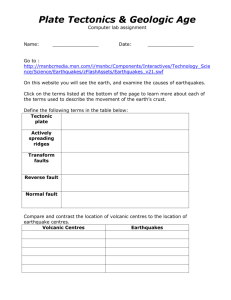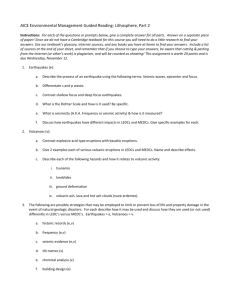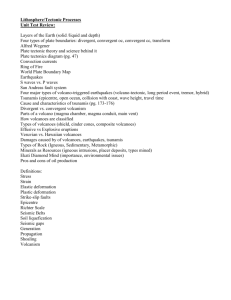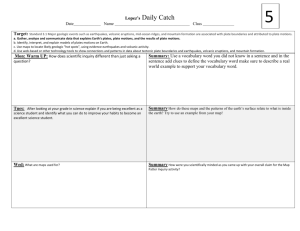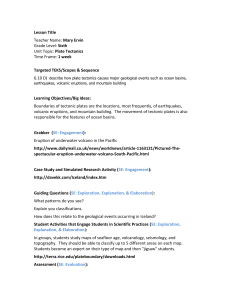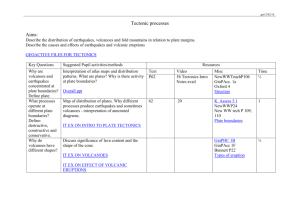Natural Disasters & Other Extreme Weather Conditions
advertisement
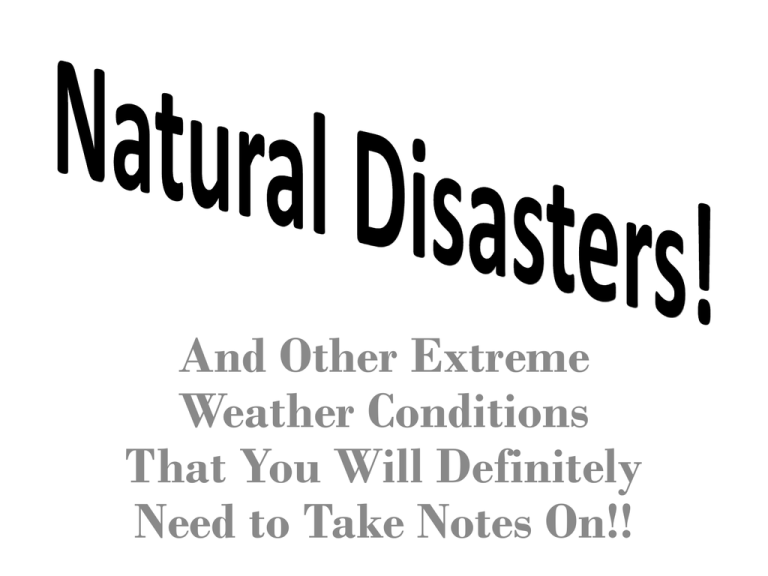
And Other Extreme Weather Conditions That You Will Definitely Need to Take Notes On!! Natural Disasters & Other Extreme Weather Conditions -Natural Disasters are not typical conditions that people can usually expect. -Although infrequent, they are events that can kill thousands of people and destroy buildings, bridges, and roads. -Some examples of Natural Disasters and other Extreme Weather conditions include, but are not limited to: -Tornadoes -Hurricanes -Wildfires -Earthquakes -Tsunamis -Volcanic Eruptions -Before we go in depth on each of these, let’s review on what we’ve learned so far about weather. What is Weather? • Weather refers to conditions in the atmosphere closest to Earth, which occur over a short period of time • Weather includes all forms of humidity, winds, and precipitation (rain, snow, or hail). • Weather is affected by latitude, elevation (height above sea level), wind patterns, ocean currents, and mountain barriers EXPLAINING VOLCANOES, EARTHQUAKES & TSUNAMIS Internal Forces At Work • • • • Volcanoes, Earthquakes, and Tsunamis are often caused by tectonic plate movement Tectonic Plates- large slabs of rock which Earth’s continents are attached to Where tectonic plates diverge, pressure in the mantle is reduced. – Some of the plate may sink or melt into the mantle, causing a weakness in the Earth’s crust Pockets of molten rock form beneath the surface. Magma breaks through, resulting in an eruption of gas, magma, and ashes – Once the magma reaches the surface, it becomes lava. • The location of earthquakes and volcanoes are almost identical with plate boundaries • “Ring Of Fire”-area around the Pacific tectonic plate where volcanic eruptions and earthquakes are most likely to occur Island Arc Formation • Many mountains and islands have been formed through volcanic eruptions • “Hot Spot”- columns of magma rises towards Earth’s surface. – If located near springs of underground water, steam pressure from the hot spot forces the water upward, producing a geyser. • Molten rock flows out a crack in Earth’s surface as tectonic plate floats over hot spot. – The Hawaiian Islands are currently located over a hot spot; therefore, it’s volcanoes are active and frequently erupt. Notable Volcanic Eruptions • Mt. Vesuvius (79 A.D.)this eruption changed the course of the Sarno River, raised sea levels, and buried thousands of Romans under volcanic ash in the city of Pompeii. • Krakatoa (1873 A.D.)volcanic explosion blew its island apart with forces a thousand times more powerful than WWII atomic bombs. Earthquakes • Plate movements cause breaks in Earth’s crust, known as faults. Sudden movements puts stress on the faults, causing vibrations known as earthquakes. • The magnitude of earthquakes and tsunamis are measured by the Richter Scale. – The Richter Scale measures the force of the quake from -1 through 9. San Andreas Fault • Lies on the boundary of the North American plate and the Pacific Plate • Over 750 miles long, the San Andreas Fault cuts through most of California, plaguing the area with frequent earthquakes Tsunamis • Huge ocean or sea wave, caused by an underwater disturbance like earthquakes, volcanic eruptions, or mudslides. • Coastal areas are especially at risk • Common warning sign is water tide recession (or pulling away from) shoreline. Unfortunately, does not give people much time to prepare. Notable Earthquakes & Tsunamis • San Francisco Earthquake of 1906: Much of San Francisco was destroyed by this quake, killing over 3000 people. – Because of California’s situation on the San Andreas Fault Line, more earthquakes are predicted in this area. • Indonesian Tsunami of 2004: waves as high as 100 feet struck Thai and Indonesian coastal communities, killing over 200,000 people. Hurricanes • Hurricanes occur in late summer and early fall, when ocean water is very warm • Warm ocean water evaporates so quickly that it creates an area of low pressure, forming an air column that begins to spin at high speeds • The hot air rises until it cools and condenses, spinning into a circular storm with a calm eye center • The longer a hurricane stays over warm water, the stronger it becomes…and the more destruction it will cause. Hurricane and Tropical Storm Chart • All Hurricanes begin as Tropical Storms, but are classified as hurricanes once winds reach speeds of 74 mph. Notable Hurricanes • Galveston Hurricane (1906)- Category 4 storm that killed 8000 people in Galveston, TX. • Hurricane Katrina (2005)- Category 3 storm that killed 1800 but cost nearly $81 billion in damages TORNADOES Beware of Flying Monkeys and Falling Houses! Tornadoes • A tornado is a windstorm that occurs over land • Caused by the collision of a warm air mass with a cool air mass • Funnel-shaped cloud that moves erratically across the ground, causing widespread destruction in a very short amount of time BLIZZARDS! (Well…Droughts, Floods, and Wildfires, too.) Blizzards • Winter storm with high winds and drifting or falling snow • Caused by the collision of high pressure systems (bringing snow) and low pressure systems (bringing wind) • There is usually a fair amount of warning , so people have adequate time to prepare shelter and protect their water pipes from freezing Floods • Rising water levels that overflow their usual boundaries • Low-lying areas near large bodies of water are at risk • Caused by an increase of water in an area, usually because of heavy rains or melting snow Wildfire • Begins in usually uninhabited areas and eventually reach where people live • Most wildfires are caused by careless human mistakes • They are more frequent in dry areas, particularly those in a drought. Drought • Long period of time with little or no precipitation (min. of 15 days) • Areas surrounding deserts are particularly at risk


